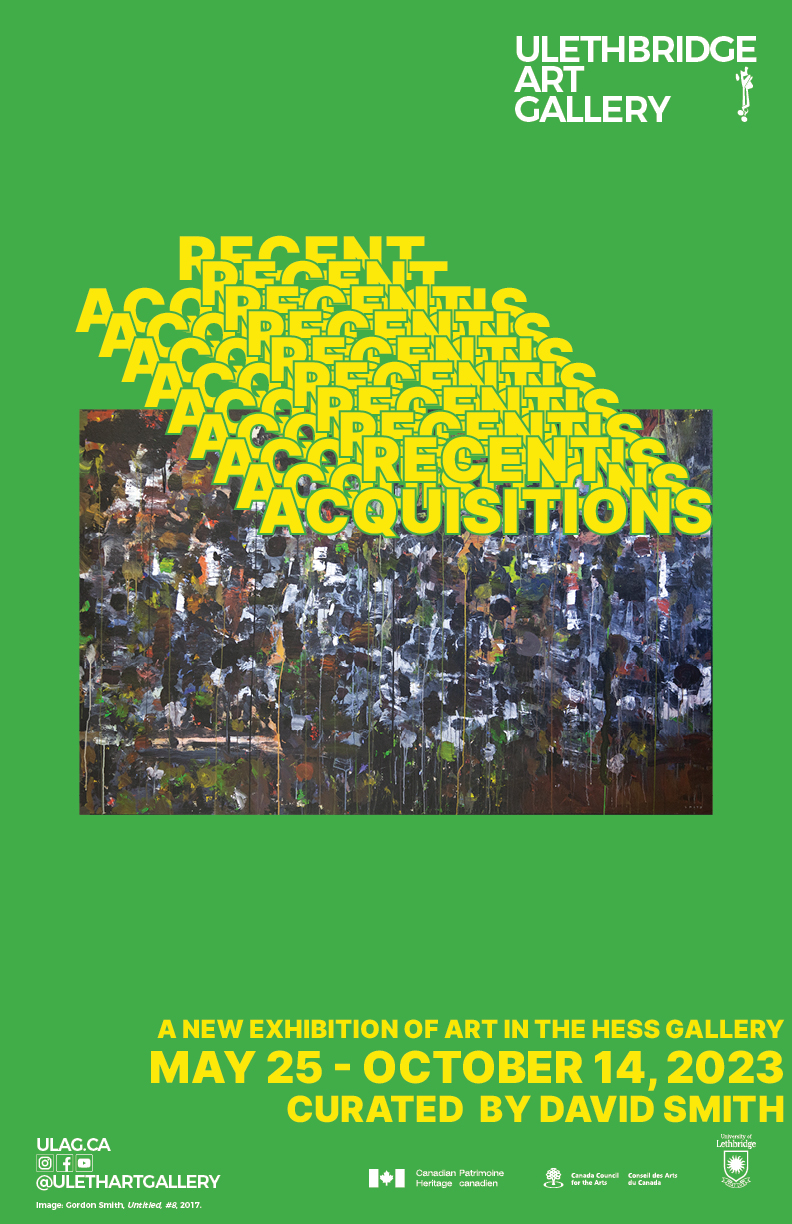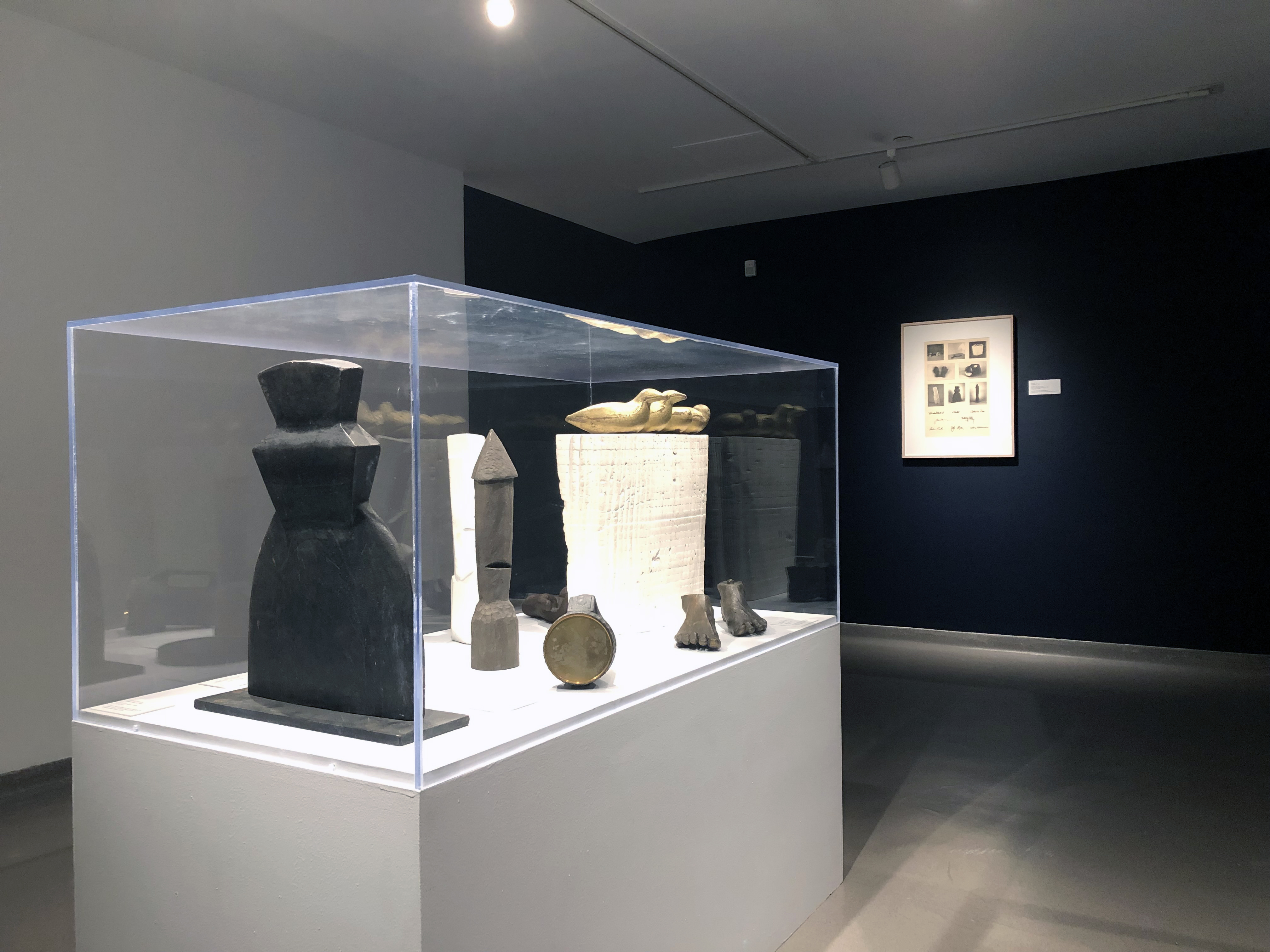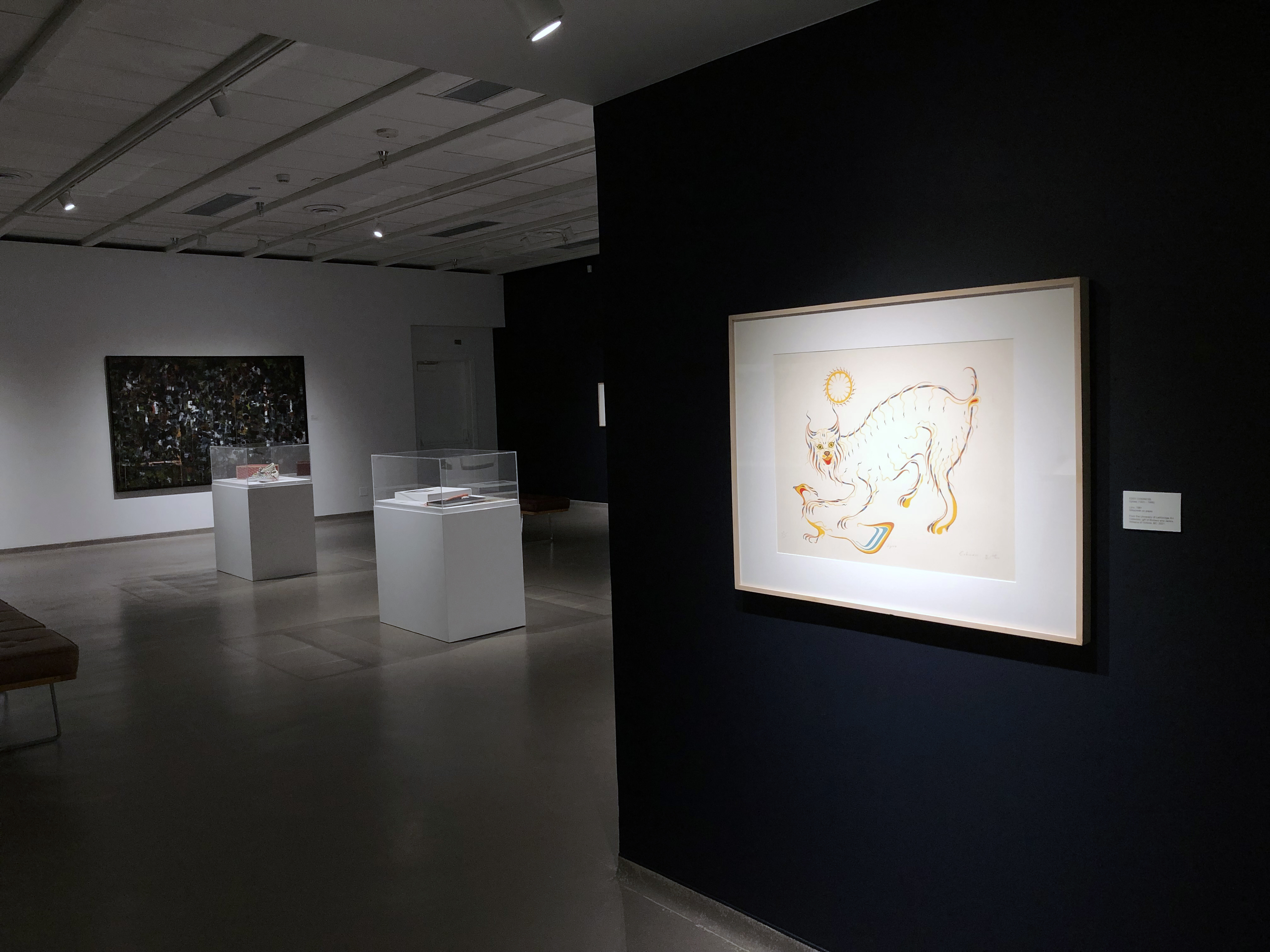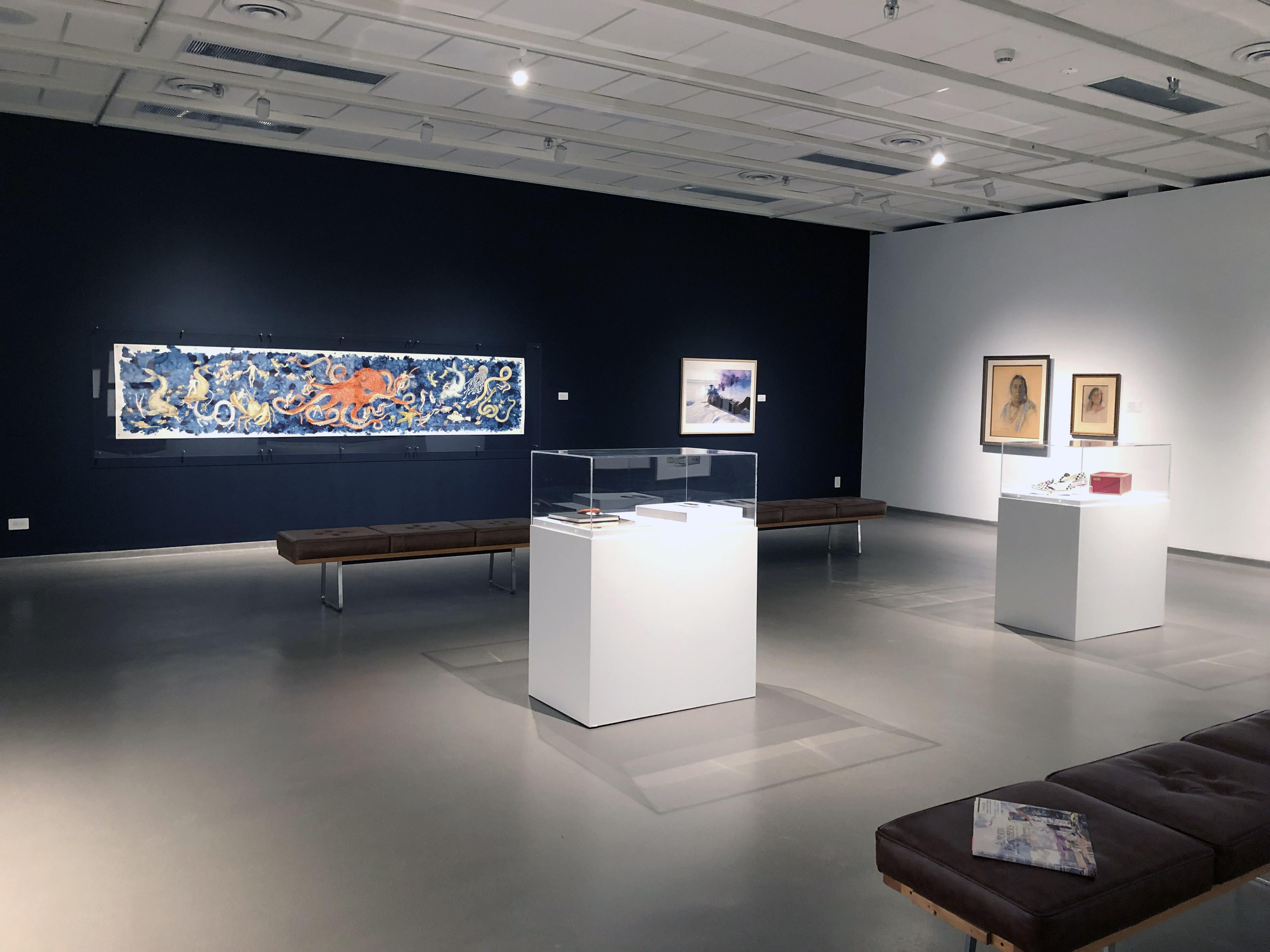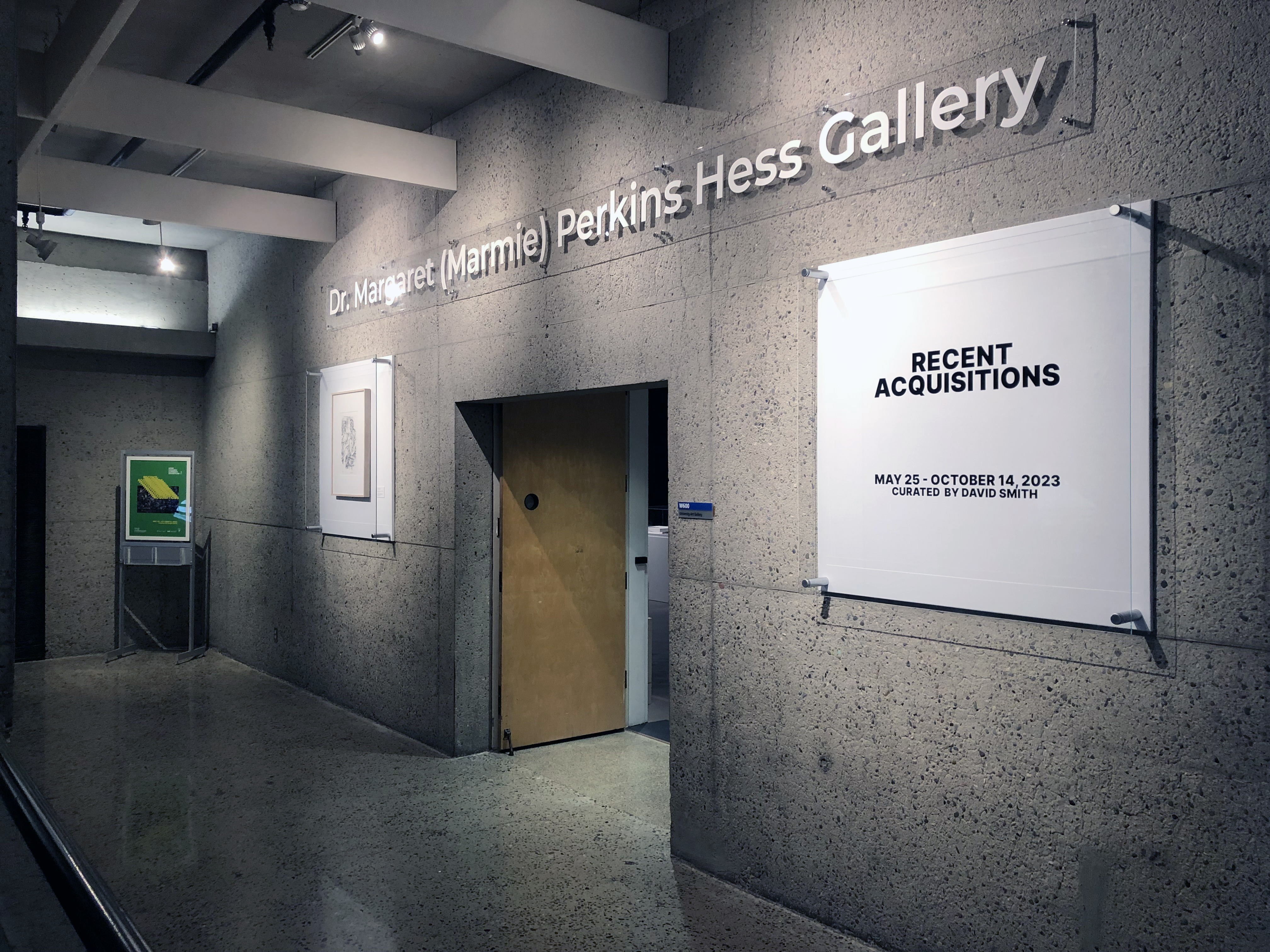Dr. Margaret (Marmie) Perkins Hess Gallery
Recent Acquisitions
May 25 – October 14, 2023
Curator: David Smith
An exhibition of newly acquired works into the University to Lethbridge Art Collection.
Curatorial Statement
Over the past decade, the University of Lethbridge Art Gallery has been the recipient of many remarkable donations. The artworks from the estate of Dr. Margaret (Marmie) Perkins Hess and those from Jim Coutts have received a great deal of publicity and generated significant excitement. This exhibition celebrates some of the artworks that have not yet been exhibited but have been generously donated by other artists and collectors who continue to advance the Gallery’s mission of connecting diverse communities and contemporary artists with our art collection.
Outside the Gallery hangs a lithograph by Oskar Kokoschka titled Athena ready to depart for Ithaka, 1964/65. This is the third in a portfolio of 44 prints published in 1965 called The Odyssey. Kokoschka is the only Austrian artist in the university’s collection and this print joins four other lithographs by the artist in the collection, which also date from the late sixties. The silkscreen print Lynx, 1981 is by Ojibwe artist Eddy Cobiness. Cobiness was one of the seven artists who began exhibiting together as the Professional Native Indian Artists Inc. in 1973 in an effort to challenge the perceptions of contemporary Indigenous art. While other artists from this group including Alex Janvier, Daphne Odjig and Norval Morrisseau are well-represented in the university’s collection, this print is our first work by Cobiness and is a significant addition to the holdings of work by Indigenous artists.
Joseph Anderson’s watercolour, The Boys Encounter Aquatic Creatures Near the Ocean Floor (2010), builds on the Gallery’s collection of more than 1,200 works in the watercolour medium by artists from around the world. It’s unusual panoramic format and fantastical yet dark subject matter make viewing the largest watercolour in the university’s collection a visual delight. Karen Brownlee’s watercolour paintings from the Rural Prairie Communities series employ a similar sense of whimsy through her use of fantastical colours to create both visual interest and a strong sense of cohesion in her oeuvre. Her many iterations of the sublime role of the grain elevator in the prairie landscape conveys a sense of place for those familiar with rural Alberta living.
The University of Lethbridge holds the most comprehensive collection of Nicholas de Grandmaison material in the world, including over one hundred portraits of Indigenous subjects. The growth of this collection has been supported over the years by donations from the artist’s family in 1989 and by a collection of sixty-seven portraits donated by BMO Financial Group in 2012. The two works in this exhibition by De Grandmaison have recently come from private collections. De Grandmaison’s first documented visit to Saskatchewan was in 1930, and the smaller undated portrait depicts Mrs. Mary Two Bears, a Sioux woman from Muscowpetung First Nation in Saskatchewan. The portrait is believed to be a very early example from his career, which spanned over fifty years. The larger portrait depicts Atso’toah (Chief Shot-Both-Sides), a man that De Grandmaison is known to have drawn several times – the first time from as early as 1936. Atso’toah was born in 1874 and was the grandson of Chief Red Crow who signed Treaty 7 on behalf of the Blood Tribe. He was elected Chief in 1913 and served in this role until his passing in 1956. This undated portrait joins two others in the collection which depict the sitter in 1949 and 1954.
The large acrylic painting by Gordon Smith is a stunning work of abstraction. Smith’s artistic practice has been described as pushing the dialogue between representational and abstract painting, although this work falls much further to the abstraction side of the spectrum. This canvas greatly enhances the gallery’s holdings of work by the artist as the existing forty-six works were all created before 1992 and the artist continued painting until his passing in 2020 at the age of 100. This painting was gifted to the gallery in honour of the late artist.
The contemporary photograph by Katherine Takpannie is an exciting addition to the Gallery’s collection of work by Inuit artists. Our collection holds more than 1,500 works in print, drawing and sculpture from across the Arctic which were almost entirely created before 1990. Not only is this the first photographic work by an Inuk artist in the collection, but it also helps illustrate the rich and unfolding story of Inuit art today. This photograph comes to the collection in honour of Diana Lanier, a longtime supporter of the arts in Lethbridge and beyond. The suite of sculptures in the alcove also have a connection to the Lanier family. They were cast in 1995 in an edition of just six and sold by the Art Gallery of Nova Scotia to raise money for the David Lanier “Big Hat, No Cattle” Sculpture Scholarship which continues to recognize excellence in sculpture at the Nova Scotia College of Art and Design annually. The collection features some familiar local names including Catherine Ross and Glen MacKinnon as well as other distinguished Canadian artists.
Contemporary artists Sarah Fuller, Serene Weasel Traveller and Rita McKeough have all worked with the Gallery in various capacities in recent years. Gallery visitors may remember Sarah Fuller’s exhibition Refugio (2018) or Rita McKeough’s The Lion’s Share (Food Series) from 2011. Fuller’s digital collage works in this exhibition were inspired by her time spent at the Coutts Centre for Canadian Heritage in Nanton, AB. Using archival source material found at the Centre and records of bird sightings on the property, the artist created a series of illustrations that reflect the local wildlife and convey a sense of place through the prism of domestic interior. McKeough’s monograph documents her collaborative artistic practice and pedagogy dating back to the 1970s. This special set includes a humorous editioned sculpture and a vinyl record that contains five audio works from installations and performances between 1991 and 2017. Serene Weasel Traveller’s beaded shoes were created in an Indigenous Art Studio class here at the University and presented in a virtual exhibition during the pandemic. The prairie crocus beading pattern comes from a pair of moccasins in the collection of Cambridge Museum of Archeology and Anthropology. Digital 3D scans of the pair from Cambridge were created by Mootookakio’ssin “Distant Awareness”, a long-term research project which brings home digital renderings of non-sacred Blackfoot objects that are housed in European museums.
On behalf of the gallery, I’d like to express our sincere gratitude to all the many artists and donors who continue to support the growth of our collection.
David Smith
Assistant Curator / Preparator
